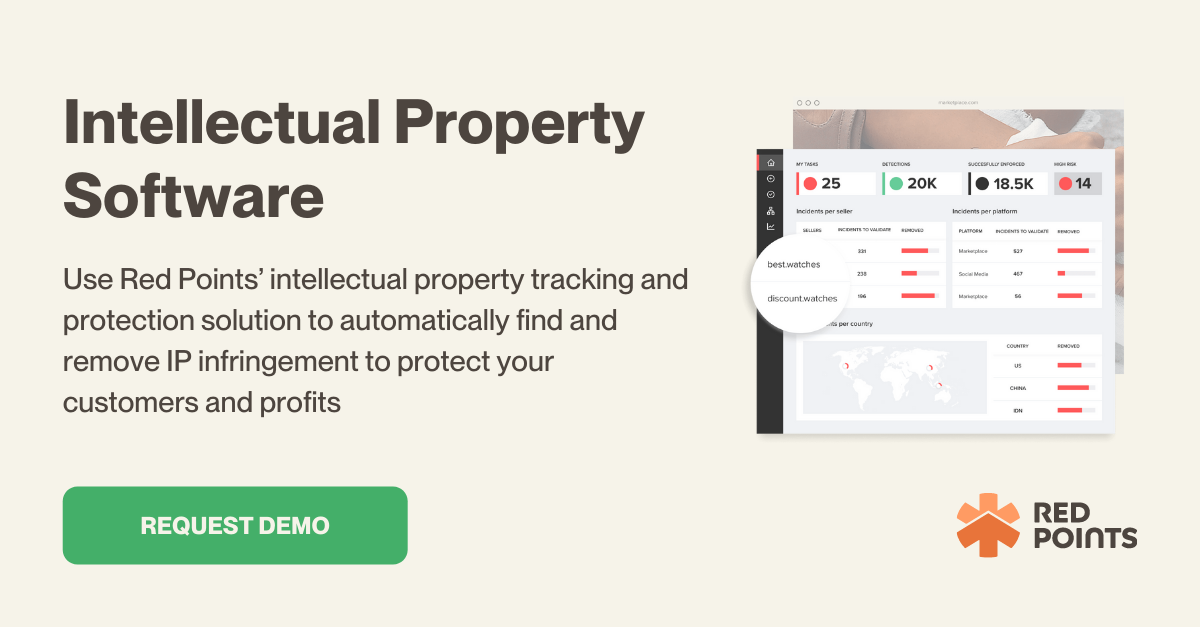From groundbreaking inventions to creative content and distinctive symbols, your original designs and creations act as invaluable assets for your brand. This is why it’s so important for business owners to take the vigilant protection of their work seriously. And that includes acting fast against the ever-evolving tactics of infringers.
Understanding the ins and outs of intellectual property (IP) infringement is key to keeping your creations safe so that your brand’s reputation remains safe and your original work can thrive.
In this guide, we look at the different types of IP infringements, shedding light on the various ways your intellectual assets can be compromised. Whether you’re navigating the complex web of copyright laws, warding off counterfeiters, or preempting patent breaches, we’ll offer strategies that will fortify your digital defenses.

What is considered intellectual property infringement?
It is illegal to violate the Intellectual Property Rights (IPR) that are attached to a piece of intellectual property in any way. Owners of IPRs have the power to prevent others from reproducing, duplicating, or exploiting their work.
Intellectual Property infringement might fall into numerous categories:
Copyright infringement: A copyright is a legal right given to the copyright owner of original work, such as a photograph, literature, video, music, or other creative activity. When you use a picture that is not your own or for which you have not been granted permission to use, you may be infringing on the rights of the original creator. If you decide to work with a freelance content writer, for example, you should always use a plagiarism checker for the content they create to make sure it’s original. Skipping this step could unknowingly get you tangled up in copyright infringement.
Trademark infringement and counterfeiting: A trademark is a term, symbol, phrase, or design that identifies and legally distinguishes one entity’s product or service from that of another. Unauthorized use of a trademark in such a way that could lead customers to be confused about the product’s origins, or whether the person selling the counterfeit goods is affiliated with the true trademark owner, is trademark infringement.
Counterfeiting: In the eyes of the law, counterfeiting is a form of trademark infringement. For the most part, counterfeit products don’t look like the real thing, but they’re designed to fool customers into thinking they’re getting something authentic.
Patent infringement: Patents guard against unauthorized replication, usage, copying, or sale of an innovation. Patents can cover manufactured goods, machines, designs, and a variety of other products and processes. There are regional patent offices in each country where one can apply for patent registration. Patent infringement occurs when someone makes, uses, sells, or offers to sell a patented product or design without the consent of the patent owner.
Rights of publicity: Individuals’ rights to publicity prevent all members of the public from having their names, likenesses, or other recognized features of their identities exploited without permission in product listings, ads, or other commercial operations. Using a third party’s publicity rights without their permission may be considered a violation of their right to privacy.
Common examples of Intellectual property violations
IP infringement can occur in a variety of ways, but some of the more common ones are as follows:
- Fake websites that try to pass themselves off as the official outlet for one or more of the IP owner’s brands.
- Putting your logo on an IP-protected product to boost sales.
- An infringer copying and passing off your writing or artwork as their own.
- Intellectual Property infringements on social media where fraudulent profiles use trademarks or copyrighted material to represent a brand.
- Stealing confidential information (with or without an employment agreement).
- Building patent-protected things without your permission.
- Infringement on search engines such as Google can take a variety of forms. Examples include URLs that allow unauthorized merchants to sell counterfeit copies of your items while also providing illegal access to protected content on search engines. Another example is high-ranking impersonating sites that replicate your company’s identity.
- Intellectual Property infringements in mobile app marketplaces and third-party sites where fraudulent apps install malware designed to steal user credentials for harmful purposes or to misrepresent your brand.
- The practice of selling or leasing your patent to a party who does not have the proper legal authority to do so.
- The rise of deep fakes—hyper-realistic digital manipulations of images, videos, or audio files—makes it harder for people to know that the visual or audio they’re consuming is not legitimate. Brands need to be increasingly aware of deep fake IP infringements.
Ecommerce websites have been involved in numerous intellectual property conflicts.
Amazon and Barnes & Noble, for example, engaged in a legal struggle over the “single-click” or “one-click” purchasing method. The parties reached a private settlement in this case.
Several businesses have filed lawsuits against Google, alleging that the search engine is infringing on their intellectual property rights by using their trademarks as terms. Legal action against the company was initiated by American Airlines and Geico.
Intellectual property violation can affect your brand in a number of ways if it isn’t addressed, such as:
- Revenues are being lost. Market sales plummet as a result of the diversion of customers caused by infringing IP listings
- Relationships with partners suffer as a result of IP infringement. The authorized distributors of your items suffer unfair competition from low-cost knockoffs.
- Reputational damage to a company’s name and logo. Consumers’ health and safety are put at risk due to distorted user perceptions.
How to avoid intellectual property infringement?
1. Consider trademarking your brands’ names and logos, as well as applying for design and utility patents for each product.
Pro-tip: Trademarks should preferably cover places where counterfeiting is a problem.
2. Enroll your brand in all major Ecommerce anti-counterfeit schemes, such as Amazon Brand Registry or eBay Verified Rights Owner, for free.
3. Before committing to cooperate with a potential partner, you should share nondisclosure agreements (NDAs) with them. NDAs are frequently used to protect trade secrets. When a party to an agreement violates the agreement by disclosing all or parts of a trade secret to uninterested others, the trade secret is infringed upon. When an NDA is not present, it is possible to be guilty of trade secret violation.
4. Register your brand’s most obvious domain variants.
This is another efficient approach to defend a brand from cybersquatters who claim domain names in order to profit from legitimate businesses’ trademarks.
The Domain Takedown Solution from Red Points detects and removes spoofing sites that try to profit off your brand. It analyzes search engines and domain databases in three steps to automatically find and report phony websites:
- Discovery of fake websites via social media, search engines, and domain databases.
- Immediately notifying the domain registrant, CMS platform, and server hosting of the domain shutdown.
- Stopping repeat infringers by tracking down scammers’ identities and using data to pursue legal action.
5. AI technology can help you safeguard your intellectual property online 24 hours a day, 7 days a week.
Use the most advanced brand protection technology from Red Points, to automatically discover and process thousands of intellectual property (IP) infringements, focusing on the most dangerous offenders first.
How Red Points works:
- It automatically crawls the internet, using powerful image recognition and bot-powered searches to find potential infringements for you.
- You can validate or reject violations 24 hours a day, 7 days a week. Use automated rules to review thousands of infringements faster, or use the trademark protection solution dashboard to perform human checks.
- Machine learning combines trends and keyword opportunities can help you become more effective.
What’s next
When it comes to intellectual property rules, it’s necessary to take your legal obligations and rights into consideration.
Protecting your intellectual property may help you build a stronger brand, make money from your unique assets, and keep others from using your creations without your permission. Including these essential elements in your business strategy will help you stay on top of everything.
To determine which assets should be protected, make a list of all your intellectual property. Prepare a budget for the time and money you will need to adequately secure the rights to your intellectual property. Set timelines for the study, filing, and finalization of these steps and work toward them as if they were any other company goal.
To simplify and speed up the process, use Red Points Intellectual Property software. We employ a powerful IP tracking and protection system to automatically discover and remove infringements to protect your customers, your brand, and your revenue.






